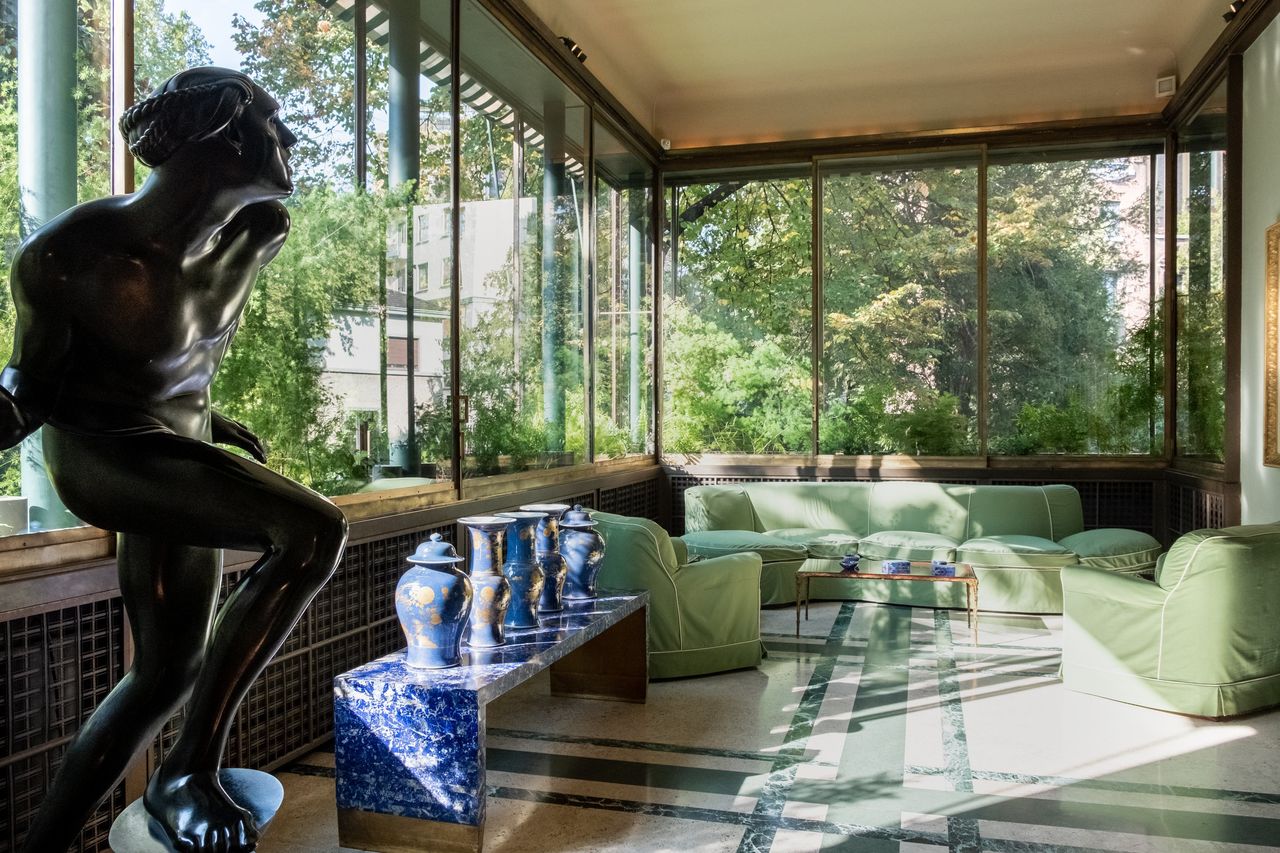How Mixing Materials Brings Luxury to Interior Design
The exquisite finishes—glass, marble, brass, leather—of a famed 1930s villa in Milan inspires a design writer to rethink her plain old wood-on-wood world
MILAN HAS A GRITTY GLAMOUR that doesn’t endear itself to every visitor, but on my first visit I was surprised how much I liked it. From the imposing, imperial stone behemoth of Milano Centrale train station, I walked down the dusty, grand streets straight to the Villa Necchi Campiglio, a 1930s house and walled garden set like an emerald in the heart of Milan.
I’d wanted to go ever since I saw Luca Guadagnino’s 2009 film “I Am Love,” in which the house served as both the set and soul of the story, a restrained but sumptuous vision of Italian architecture. Designed by fashionable Milanese architect Piero Portaluppi and built between 1932 and 1935 for the wealthy industrialist Angelo Campiglio, his wife and her sibling (the Necchi sisters) the house affirms that the jewels of Milan are often found behind lock and key.
Thanks to heritage foundation FAI (Fondo Ambiente Italiano), the luxurious glass doors of the once-private residence now admit visitors. As I wound my way through its garden, golden light filtered through century-old plane trees, dappling Japanese anemones and ferns. Bands of marble, granite and ceppo stone wrap the facade of the home, its otherwise forebodingly glamorous entry softened by semicircular steps. I braced myself and entered.
Elegance is rarely more faultless than the home’s soaring ground floor, from its walnut and rosewood parquet to its briar-root panelled walls and broad staircase with Greek-key balustrade. Works by Morandi and Modigliani, found throughout, add another layer of refinement.
“The story of the house tells the story of Milan,” said Marco Fincato of the FAI. “It combines the power of industry, fashion and design.” Portaluppi’s gift was mixing luxurious materials and references, from the sensuality of Art Deco to the rigour of Italian Rationalist architecture. Rationalism was essentially a fascist movement, said Mr. Fincato, and while Mussolini’s regime proved ruinous for Italy, the resulting influx of money and power gave architects a brief chance to shine.
Shine, the Villa Necchi does. A wall of brass-trimmed, double-paned windows defines the sparkling glass veranda. As if in a greenhouse, plants grow in the 12 or so inches of space between the two panes. Uninterrupted views of the garden, jadeite s-curved upholstery and the geometric check of the green marble floors boost the sense of verdure. A lapis lazuli side table faces an 18th-century Japanese lacquer cabinet, exemplifying the way the Villa’s materials complement, and contrast with, each other.
It feels as though Portaluppi has dressed the house with different finishes to send her off for a glittering night of opera at La Scala. Each room features sliding doors inset with mercury mirror or interlocking bricks of silver alloy. They open with a whisper and lock down like a fortress. Goatskin-parchment paneling swaths the dining room, whose plaster ceiling is spangled with constellations. Even the radiators sport bespoke brass chain-mail covers that swish like earrings.
As Marianna Kennedy, a designer whose eponymous atelier in London is renowned for lacquer, mirror and bronze work, later told me, “The wonderful detailing and restrained lines of the Portaluppi interiors are quite simple, but the finishes make it extraordinary.”
I climbed the stairs, letting my hand sweep the walnut balustrade. The sleeping quarters function as separate apartments, and while the relatively humble bedrooms feel almost spartan, the bathrooms are dazzling. Thick blush-marble slabs create towering stalls for the showers and toilets; luxuriant bathtubs anchor the rooms. “Only in Italy could bathrooms like this be made, with the availability of so much marble,” said Mr. Fincato.
I stayed until the setting sun glinted across the polished floors and distant, celebratory pops of prosecco could be heard from the garden. There would be a private party that evening, and I could almost feel the house’s soul stir back to life. Was I invited? No, but it didn’t matter. I was taking a spark of insight home with me. The magic of the place is in its heady cocktail of materials—mirror, lacquer, stone, leather, metals, glass. I vowed to avoid living the rest of my life surrounded only by old, brown wooden furniture.
As I left, waiters in dinner jackets poured coups at the bar as chic partygoers arrived. “The house feels timeless yet so of its place,” said Ms. Kennedy. “Milan looks austere and unforgiving in a way, but you go through a courtyard door, and a hidden, beautiful world unfolds.”
 Copyright 2020, Dow Jones & Company, Inc. All Rights Reserved Worldwide. LEARN MORE
Copyright 2020, Dow Jones & Company, Inc. All Rights Reserved Worldwide. LEARN MORE
This stylish family home combines a classic palette and finishes with a flexible floorplan
Just 55 minutes from Sydney, make this your creative getaway located in the majestic Hawkesbury region.
As Paris makes its final preparations for the Olympic games, its residents are busy with their own—packing their suitcases, confirming their reservations, and getting out of town.
Worried about the hordes of crowds and overall chaos the Olympics could bring, Parisians are fleeing the city in droves and inundating resort cities around the country. Hotels and holiday rentals in some of France’s most popular vacation destinations—from the French Riviera in the south to the beaches of Normandy in the north—say they are expecting massive crowds this year in advance of the Olympics. The games will run from July 26-Aug. 1.
“It’s already a major holiday season for us, and beyond that, we have the Olympics,” says Stéphane Personeni, general manager of the Lily of the Valley hotel in Saint Tropez. “People began booking early this year.”
Personeni’s hotel typically has no issues filling its rooms each summer—by May of each year, the luxury hotel typically finds itself completely booked out for the months of July and August. But this year, the 53-room hotel began filling up for summer reservations in February.
“We told our regular guests that everything—hotels, apartments, villas—are going to be hard to find this summer,” Personeni says. His neighbours around Saint Tropez say they’re similarly booked up.
As of March, the online marketplace Gens de Confiance (“Trusted People”), saw a 50% increase in reservations from Parisians seeking vacation rentals outside the capital during the Olympics.
Already, August is a popular vacation time for the French. With a minimum of five weeks of vacation mandated by law, many decide to take the entire month off, renting out villas in beachside destinations for longer periods.
But beyond the typical August travel, the Olympics are having a real impact, says Bertille Marchal, a spokesperson for Gens de Confiance.
“We’ve seen nearly three times more reservations for the dates of the Olympics than the following two weeks,” Marchal says. “The increase is definitely linked to the Olympic Games.”

Getty Images
According to the site, the most sought-out vacation destinations are Morbihan and Loire-Atlantique, a seaside region in the northwest; le Var, a coastal area within the southeast of France along the Côte d’Azur; and the island of Corsica in the Mediterranean.
Meanwhile, the Olympics haven’t necessarily been a boon to foreign tourism in the country. Many tourists who might have otherwise come to France are avoiding it this year in favour of other European capitals. In Paris, demand for stays at high-end hotels has collapsed, with bookings down 50% in July compared to last year, according to UMIH Prestige, which represents hotels charging at least €800 ($865) a night for rooms.
Earlier this year, high-end restaurants and concierges said the Olympics might even be an opportunity to score a hard-get-seat at the city’s fine dining.
In the Occitanie region in southwest France, the overall number of reservations this summer hasn’t changed much from last year, says Vincent Gare, president of the regional tourism committee there.
“But looking further at the numbers, we do see an increase in the clientele coming from the Paris region,” Gare told Le Figaro, noting that the increase in reservations has fallen directly on the dates of the Olympic games.
Michel Barré, a retiree living in Paris’s Le Marais neighbourhood, is one of those opting for the beach rather than the opening ceremony. In January, he booked a stay in Normandy for two weeks.
“Even though it’s a major European capital, Paris is still a small city—it’s a massive effort to host all of these events,” Barré says. “The Olympics are going to be a mess.”
More than anything, he just wants some calm after an event-filled summer in Paris, which just before the Olympics experienced the drama of a snap election called by Macron.
“It’s been a hectic summer here,” he says.

AFP via Getty Images
Parisians—Barré included—feel that the city, by over-catering to its tourists, is driving out many residents.
Parts of the Seine—usually one of the most popular summertime hangout spots —have been closed off for weeks as the city installs bleachers and Olympics signage. In certain neighbourhoods, residents will need to scan a QR code with police to access their own apartments. And from the Olympics to Sept. 8, Paris is nearly doubling the price of transit tickets from €2.15 to €4 per ride.
The city’s clear willingness to capitalise on its tourists has motivated some residents to do the same. In March, the number of active Airbnb listings in Paris reached an all-time high as hosts rushed to list their apartments. Listings grew 40% from the same time last year, according to the company.
With their regular clients taking off, Parisian restaurants and merchants are complaining that business is down.
“Are there any Parisians left in Paris?” Alaine Fontaine, president of the restaurant industry association, told the radio station Franceinfo on Sunday. “For the last three weeks, there haven’t been any here.”
Still, for all the talk of those leaving, there are plenty who have decided to stick around.
Jay Swanson, an American expat and YouTuber, can’t imagine leaving during the Olympics—he secured his tickets to see ping pong and volleyball last year. He’s also less concerned about the crowds and road closures than others, having just put together a series of videos explaining how to navigate Paris during the games.
“It’s been 100 years since the Games came to Paris; when else will we get a chance to host the world like this?” Swanson says. “So many Parisians are leaving and tourism is down, so not only will it be quiet but the only people left will be here for a party.”
This stylish family home combines a classic palette and finishes with a flexible floorplan
Just 55 minutes from Sydney, make this your creative getaway located in the majestic Hawkesbury region.






















